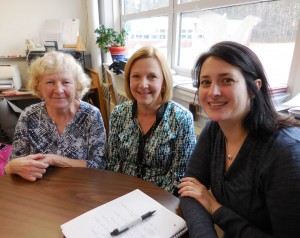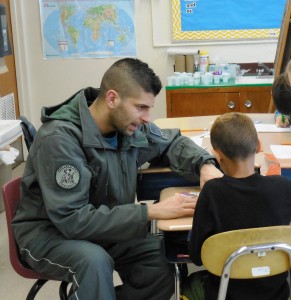
(L-R) Sue Moore, ELL Coach at Highland Elmentary, Denise Ruszala, Director of Accountability and Assessment for the District, and Mary Claire Manning, Interim Principal at Highland, oversee the program. (Photo by Amy Porter)
WESTFIELD – This September, 18 new English Language Learners (ELL) started at Highland Elementary School and three more have arrived since the start of school – “all beginners,” according to Interim Principal Mary Claire Manning.
Manning said ELL students are ranked by levels 1 to 5, and level 1 can mean “zero English.” The new students were all level 1, coming from countries as wide-ranging as Ethiopia and Tanzania to Nepal, Sri Lanka and Iraq. Some are newly-arrived in this country, and others from homes where English is not yet spoken.
Due to the large number of students arriving with very limited English, Manning, along with Denise Ruszala, Director of Assessment and Accountability for the district, and Sue Moore, an ELL coach with twenty years of experience, all saw the need for a newcomer/beginner program.
The team went to Westfield School Superintendent Suzanne Scallion. “Having so many beginners or newcomers, we were able to hire somebody,” Manning said. The new teacher for the Newcomer Program is Claire Howard, who started on November 30. She has twelve students in K-2, and eleven students in grades 4-5.
“It’s wonderful. Definitely a learning experience,” Howard said. “I wouldn’t do anything else.”
Prior to coming to Highland, Howard had completed student teaching in Chicopee. This is her first full-time teaching job.
Currently, along with the newcomers, there are 158 ELL learners at Highland Elementary, or 40 percent of the student body, according to Moore. State law says that they must have equal access and opportunity for education, and a certain number of mandated minutes in ELL. All of the content teachers (e.g. reading, math and social studies) also receive Sheltered English Immersion (SEI), which gives them background, method and tools to work with the ELL students, and is attached to their license.
“It’s extremely fulfilling, but exhausting for the teachers,” Ruszala said. “They’re being asked to differentiate from non-English speaking to gifted.”
The largest groups of ELL students by numbers in the Westfield district are Russian-speaking, coming from the Ukraine, Moldova, Kazakhstan, Latvia, and Russia. Next largest are Bhutanese refugees that came through Nepal. Next largest are Arabic speaking, mainly from Iraq. Spanish-speakers are the smallest population by numbers in the ELL program.
Ruszala said there are currently 35 ELL students at South Middle School, and 40 at the high school, and the numbers are growing with the new students that came this fall, many who were refugees from extremely needy families.
“For high school students, the gap is greater,” she said. “When I have a 17-year-old coming from Tanzania with little schooling, from a refugee camp with no running water, (that student) is so far behind.”
Westfield has a refugee school impact grant from the Office of Refugee Resettlement that pays for bilingual paraprofessionals and short term tutors. The district also hires refugees as bilingual paraprofessionals. Manning said Highland has two Nepali, two Arabic, two Spanish and two Russian paraprofessionals.
“Some will get mentors. Some will get academic support,” Ruszala said. “That’s where a newcomer program at the secondary level is needed.”
Students that come in kindergarten or first grade, by contrast, transition out of the ELL program by the time they’re in fifth grade.
The district also receives support from Title III in a combined effort of the federal and state government to provide assistance for language instruction for limited English proficient and immigrant students, and from Title I, a federal grant program that provides financial assistance to schools with high numbers or high percentages of children from low-income families.
“We’re very proactive, and try to anticipate changes before they happen,” Ruszala said. “I’m proud of it. Our ELL sub-group has met and exceeded our goals for the past three years.”
“As far as being in the school, I think we all feel very lucky,” Moore said.



